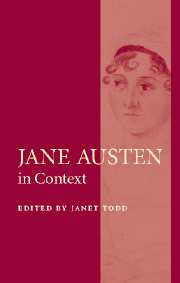20 - Domestic Architecture
Published online by Cambridge University Press: 19 December 2020
Summary
When Catherine Morland is invited to Northanger Abbey she reflects on the house she was to visit, ‘With all the chances against her of house, hall, place, park, court, and cottage, Northanger turned up an abbey’ (2:2). A sensitivity to different types of house is typical of Austen's age, as is reflected with a similar vein of humour in the titles of Thomas Love Peacock's works, for instance Headlong Hall (1815) and Nightmare Abbey (1818), which refer to hall, court, abbey, castle and grange. Austen's list indicates the variety of house types which her characters might experience, a variety which expresses the settled nature of the English counties in which her novels are set. As any house which is at all substantial will usually outlast its first occupants a settled society is likely to show examples of houses of different periods. The different names for house types reflect differences in origin, size and function. They are also in Austen's novels the opportunity for satire on social anxiety or pretension. Mary Crawford is glad to be assured that Mansfield Park justifies its name with ‘a real park five miles round’ (1:5). Sir William Lucas celebrates his knighthood by moving to a house in the country ‘denominated from that period Lucas Lodge’ (P&P, 1:5).
Two important periods of Austen's own life were spent in villages in Hampshire. Her youth was spent in Steventon Rectory and her last years in a cottage in Chawton. Between these two periods (1801–9) she lived in Bath, Clifton and Southampton. While the sorts of house commonest in these places are present in her novels – the parsonage, cottage and urban house or flat – the best known of the houses in the novels are in the country and are larger, and grander, than these. This has caused commentators to consider the houses which Austen visited. They are many, spread over the southern and south-midland counties of England, and particularly in Hampshire and Kent. An impression of the outside of these houses can be got from the illustrations in Nigel Nicolson's The World of Jane Austen (1991).
- Type
- Chapter
- Information
- Jane Austen in Context , pp. 225 - 233Publisher: Cambridge University PressPrint publication year: 2005
- 3
- Cited by



